Resnick & Halliday Solutions for Chapter: Force and Motion-I, Exercise 1: Problems
Resnick & Halliday Physics Solutions for Exercise - Resnick & Halliday Solutions for Chapter: Force and Motion-I, Exercise 1: Problems
Attempt the practice questions on Chapter 5: Force and Motion-I, Exercise 1: Problems with hints and solutions to strengthen your understanding. Principles Of Physics International Student Version solutions are prepared by Experienced Embibe Experts.
Questions from Resnick & Halliday Solutions for Chapter: Force and Motion-I, Exercise 1: Problems with Hints & Solutions
A object is driven along the axis by a variable force that is directed along that axis. Its position is given by, where, is measured in meters and in seconds. The factor is a constant. At , the force on the particle has a magnitude of and is in the negative direction of the axis. Find the value of .
Two horizontal forces and act on a disk that slides over frictionless ice, on which an x, y coordinate system is laid out. Force is in the positive direction of the x axis and has a magnitude of . Force has a magnitude of . The figure shown below gives the x component of the velocity of the disk as a function of time t during the sliding. What is the angle between the constant directions of forces and
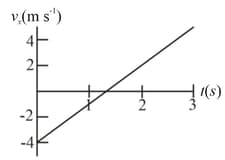
Two particles of masses and are placed on a smooth horizontal table. A string, which joins these two masses, hangs over the edge supporting a pulley, which suspends a particle of mass , in figure shown below. The pulley has negligible mass. The two parts of the string on the table are parallel and perpendicular to the edge of the table. The hanging parts of the string are vertical. Find the acceleration of the particle of mass .
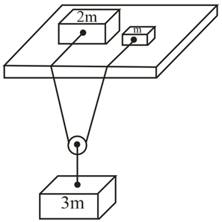
A block with a weight of is at rest on a horizontal surface. A upward force is applied to the block by means of an attached vertical string. What are the magnitude and the direction of the force of the block on the horizontal surface?
A salami is supported by a cord that runs to a spring scale, which is supported by a cord, hanging from the ceiling in the figure shown below. What is the reading on the scale, which is marked in the SI weight units? (This is a way to measure the weight by a deli owner.)
In the figure shown below, the salami is supported by a cord that runs around a pulley and to a scale. The opposite end of the scale is attached by a cord to a wall. What is the reading on the scale? (This is the way by a physics major.)
In the figure shown below, the wall has been replaced with a second salami, and the assembly is stationary. What is the reading on the scale? (This is the way by a deli owner who was once a physics major.)
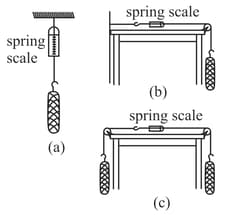
Some insects can walk below a thin rod (such as a twig) by hanging from it. Suppose that, such an insect has mass and hangs from a horizontal rod, as shown in the figure shown below, with angle . Its six legs are all under the same tension, and the leg sections nearest the body are horizontal.
(a) What is the ratio of the tension in each tibia (forepart of a leg) to the insect's weight?
(b) If the insect straightens out its legs somewhat, does the tension in each tibia increase, decrease, or stay the same?
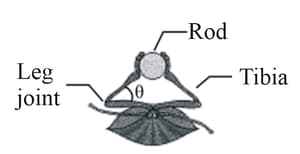
In the figure shown below, the three blocks are attached by the cords that loop over frictionless pulleys. Block lies on a frictionless table. The masses are and When the blocks are released, what is the tension in the cord at the right?
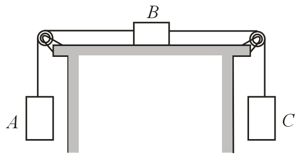
A shot putter, launches a shot by pushing it along a straight line of length at an angle of from the horizontal, accelerating the shot to the launch speed from its initial speed of (which is due to the athlete's preliminary motion). The shot leaves the hand at a height of at an angle of and it lands at a horizontal distance of . What is the magnitude of the athlete's average force on the shot during the acceleration phase? (Hint: Treat the motion during the acceleration phase as it was along a ramp at the given angle)
